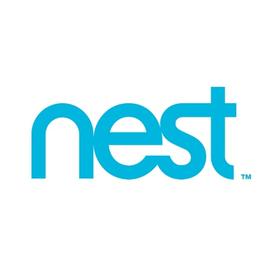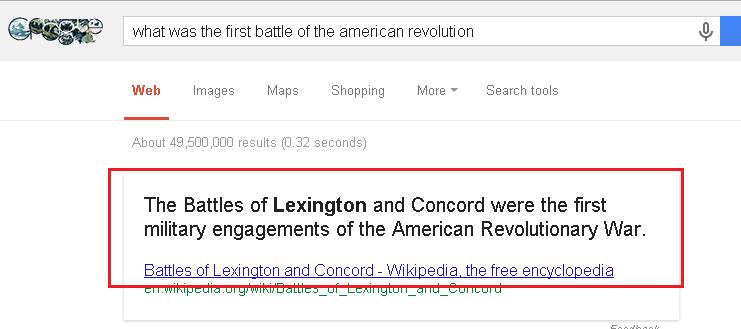
The Nest Protect is an advanced Smoke and CO2 Alarm. As part of the growing ‘internet of things’ the Protect system requires WiFi internet access so that it can interact with it’s mobile app that you can use to adjust the settings. Let’s look at some of the Nest Protect features.
- Knows what room it’s in
- Includes a speaker to talk to you
- Detects Smoke, CO2, Heat, and Light
- Has motion detection (camera?) used for gesture recognition
- Requires internet connection over WiFi
In 2012 Google launched Knowledge Graph, an attempt to do what Ask Jeeves had promised a decade ago. Typing a query into Google know shows a snippet of information. Try a question like “What wast the first battle of the American Revolution?” Typing this into Google.com brings up the answer “The Battles of Lexington and Concord were the first military engagements of the American Revolutionary War.” with a link to Wikipedia for further information followed by the classic organic listings. If you perform this same search in Google.co.uk you do not get the answer, but if you search for “american revolution” you get the Knowledge Graph listing on the right hand side that briefly explains what the American Revolution was along with images.


But then in May of 2013 Google launched another impressive feature, Conversational Search. A service where you can speak to Google your search term and, if Google has the answer, get your answer spoken back to you. But that’s not all. As Danny Sullivan of SearchEngineLand.com explains you can do a search about a person, and then a second search without using their name and Google conversational search will understand what you mean. The example Danny used in his write up was “How old is Barak Obama?” followed up by the questions “how tall is he?”, “who is is wife?”, “how old is she?” All of which returned correct answer based information.
There are a few caveats. Like most advanced search features introduced in the past few years, conversational search only works inside of Google’s Chrome browser. It also only works with voice-based search, not text based search.
So Google has a service that can answer questions, and iterate them in a continuing conversation with voice-based search. And now they are purchasing a service that is solely designed to be in each separate room of a house, with a WiFi internet connection and a speaker that talks to you.
If I were Google I would see the potential to add a microphone and a bit of software to access Google’s conversational search to the Nest Protect devices. The system could also likely have identities added to the Nest device in a room that belongs to someone. Have a roommate? The Nest Protect device in their room could be tied to their phone, and the one in your room tied to your phone. Here’s how I see the “Google Home Search Attendant” as I’m calling it working.
- A device in each room capable of detecting when you’re in the room.
- Voice commands for Conversational Search to access current and future knowledge graph queries. Using the ‘always on’ feature that turns on the microphone when you enter the room.
- Voice commands for Home search, a second service outside of conversational search. This part would have commands like “Send results to phone” that would send a query set to your phone, use Google maps to tell you how far away a place is, read back local search results, and make wifi based phone calls, or send the answer to a question to another room.
- Voice commands for alarms, alerts, and reminders.
- Voice news aggregation.
One way I see this being used is the increased integration of internet based devices. For example let’s say you’re getting ready for date night and you ask Google for a restaurant recommendation for Italian food and a romantic atmosphere in the Uptown district. House Search then reads the names and average ratings of restaurants that meet your request. You can stop the search by saying “select” or some other word, then “send to phone” or in the near future “send to car”.
I also see a Jarvis like function with the Nest Protect system being able to read you temperature, predicted weather conditions, traffic conditions, calendar reminders, and top news stories in the morning, much like what the WakeVoice App promises to do (but probably better). This would likely also be integrated with your Google Now experience.
What I’m not sure of is how optimization for this device and service will work and what Google’s monetization for this service will be. Will some ads get read out instead of organic results for certain queries? That’s probably the way it’ll go, but I’m not too sure.
What do you think? Let me know in the comments.